The Importance of Setting Goals in a Holistic Rehabilitation Plan
Harnessing the Power of Goals for Whole-Person Healing

The Foundation of Effective Rehabilitation
Achieving holistic recovery hinges upon a structured yet flexible goal-setting process that aligns with individuals' core values and personal motivations. This process not only directs therapeutic interventions but also embeds a sense of purpose and agency, fostering deeper engagement and resilient outcomes across diverse rehabilitation contexts.
Understanding the Significance of Goal Setting in Holistic Rehab
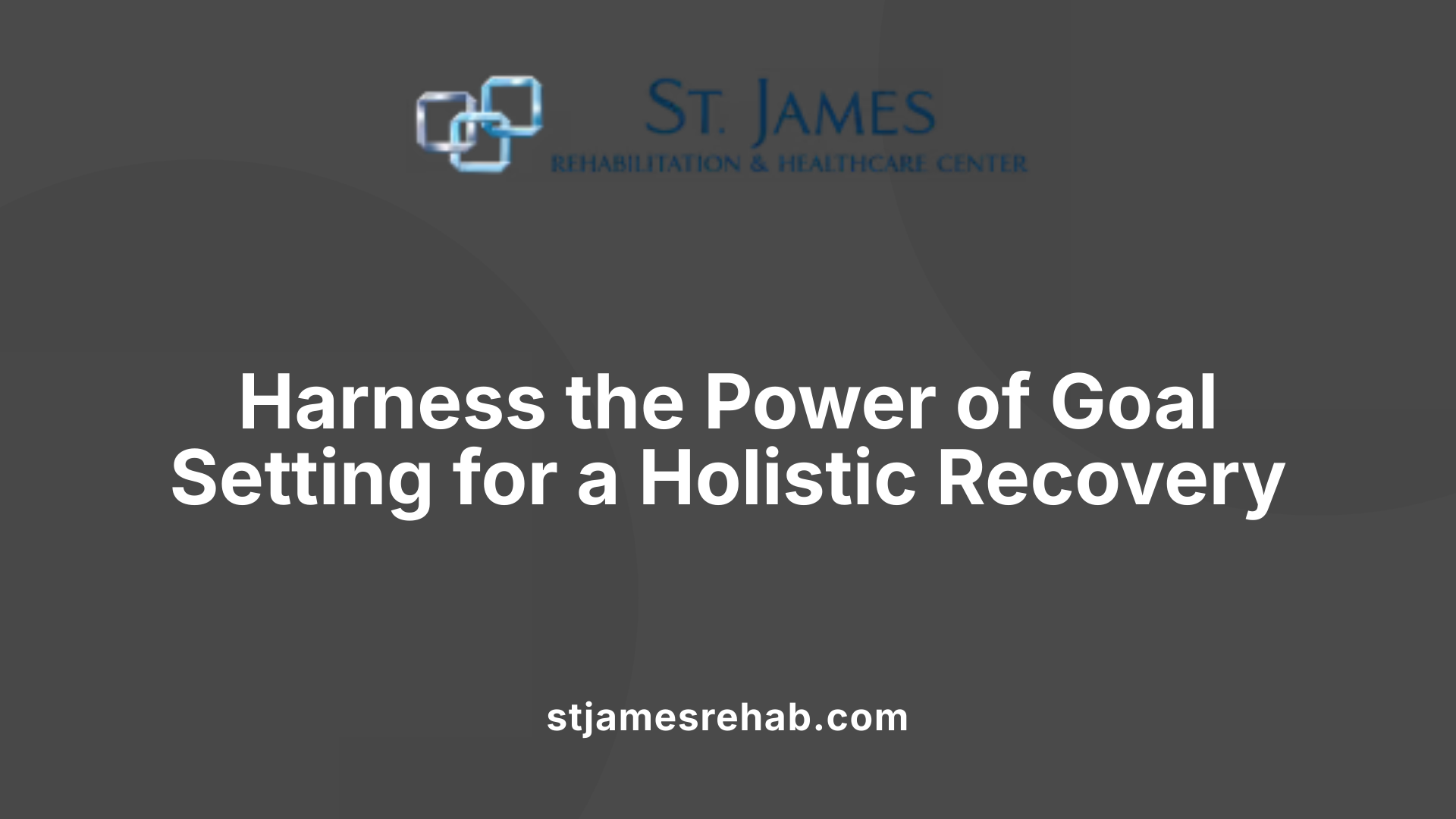
What is the importance of goal setting in a holistic rehabilitation plan?
Goal setting plays a vital role in rehabilitation by providing direction, motivation, and structure. It helps clients focus on specific outcomes and guides treatment plans effectively. When clients establish clear goals, they are more likely to engage actively in the recovery process, leading to better physical, emotional, and social outcomes.
In a holistic approach, goal setting fosters a deep connection to personal values and identities, making rehabilitation meaningful. It encourages behavior change by aligning treatment objectives with what matters most to the individual. Furthermore, collaborative goal setting involves the entire treatment team, ensuring that all strategies work toward common objectives, which improves communication and consistency.
Overall, tailored goal planning enhances motivation, supports continuous progress, and improves the success rates of rehabilitation efforts.
Why is goal setting particularly important across different types of rehabilitation, such as addiction recovery, physical therapy, and senior care?
Goals serve as a foundation for effective intervention whether in addiction treatment, physical therapy, or elderly care. Each context benefits from a personalized framework that guides the recovery process.
In addiction recovery, goals help establish motivation, accountability, and a sense of purpose, fostering resilience against cravings and setbacks. In physical therapy, concrete goals such as restoring mobility or strength provide patients with a clear pathway, improving adherence and results. For seniors in care, personalized goals focused on maintaining independence and quality of life enhance engagement and satisfaction.
Implementing shared, explicit, and structured goal-setting methods across these areas ensures clarity and facilitates continuous progress monitoring. When goals are specific, measurable, relevant, and timed (SMART), they become powerful tools that promote motivation, reinforce self-efficacy, and sustain effort over time.
By aligning interventions with individual needs and fostering active participation, goal setting significantly improves treatment effectiveness. It enhances collaboration among clients, healthcare providers, and support systems, ensuring that each person’s unique recovery journey is supported comprehensively.
How does exploring global meaning influence rehabilitation outcomes?
Exploring global meaning involves understanding clients' core beliefs, values, and attitudes. This deep dive helps to identify what is genuinely meaningful for the individual, which then informs the setting of overarching rehabilitation goals.
Sessions focusing on global meaning foster a stronger emotional connection to the recovery process. Clients often report increased motivation and intrinsic drive when their goals resonate with their personal identity and values. This alignment encourages sustained engagement and can lead to transformative behavior changes.
For clinicians, addressing global meaning helps tailor interventions more effectively and promotes team coherence. It provides context, making treatment plans more relevant and individualized.
The study indicates that such explorations are generally perceived as respectful and helpful, though not without challenges—some clients may find the process confrontational or unsuitable early in rehabilitation. Nonetheless, overall, integrating global meaning into goal-setting demonstrates promising potential to enhance the efficacy and personalization of holistic care.
How does goal setting contribute to team coherence and treatment focus?
When a shared understanding of meaningful goals exists among treatment team members, coherence in treatment planning is significantly enhanced. Addressing global meaning ensures that all providers are aligned in their approach, which streamlines communication and decision-making.
Collaborative goal development ensures that every team member—from doctors to therapists—works toward the same overarching objectives. This alignment improves treatment consistency and allows for synchronized efforts, ultimately benefiting the client.
Furthermore, team coherence around personalized goals fosters a supportive environment that emphasizes client-centered care, promoting motivation and adherence.
What are the next steps in developing and implementing this goal-setting tool?
The study highlights the initial positive reception of the tool but underscores the need for further refinement.
Future development should focus on standardizing the process, training clinicians in effective exploration of global meaning, and integrating digital tools to monitor progress.
Implementation efforts can include pilot programs in diverse settings, gathering feedback, and adjusting procedures accordingly.
Evaluation should measure long-term impacts on behavior change, motivation, and overall rehabilitation success, ensuring that the tool remains adaptable and relevant.
How does goal setting enhance the overall rehabilitation process?
In all contexts, goal setting empowers clients by giving them a sense of control and purpose.
Clear, personalized goals encourage active participation, foster motivation, and facilitate pathway clarity. Regular review and adjustments promote resilience, helping clients navigate setbacks.
Additionally, goal setting supports holistic recovery by addressing physical, emotional, and social dimensions, ultimately leading to improved quality of life.
This approach emphasizes the importance of understanding individual values and needs, making rehabilitation more engaging and effective.
How do individualized goals impact long-term recovery?
Personalized goals foster sustained motivation and a sense of ownership over the recovery journey. They help clients see tangible progress, which boosts confidence.
Adjusting goals based on ongoing assessment can prevent frustration and promote continuous improvement.
In addiction recovery, such goals help develop healthy routines and new habits, supporting long-term sobriety. In elder care, they help maintain independence and mental well-being.
Overall, individualized goal-setting ensures that recovery is relevant and meaningful, encouraging ongoing commitment and success.
Benefits of Goal Setting in Recovery and Rehabilitation Success
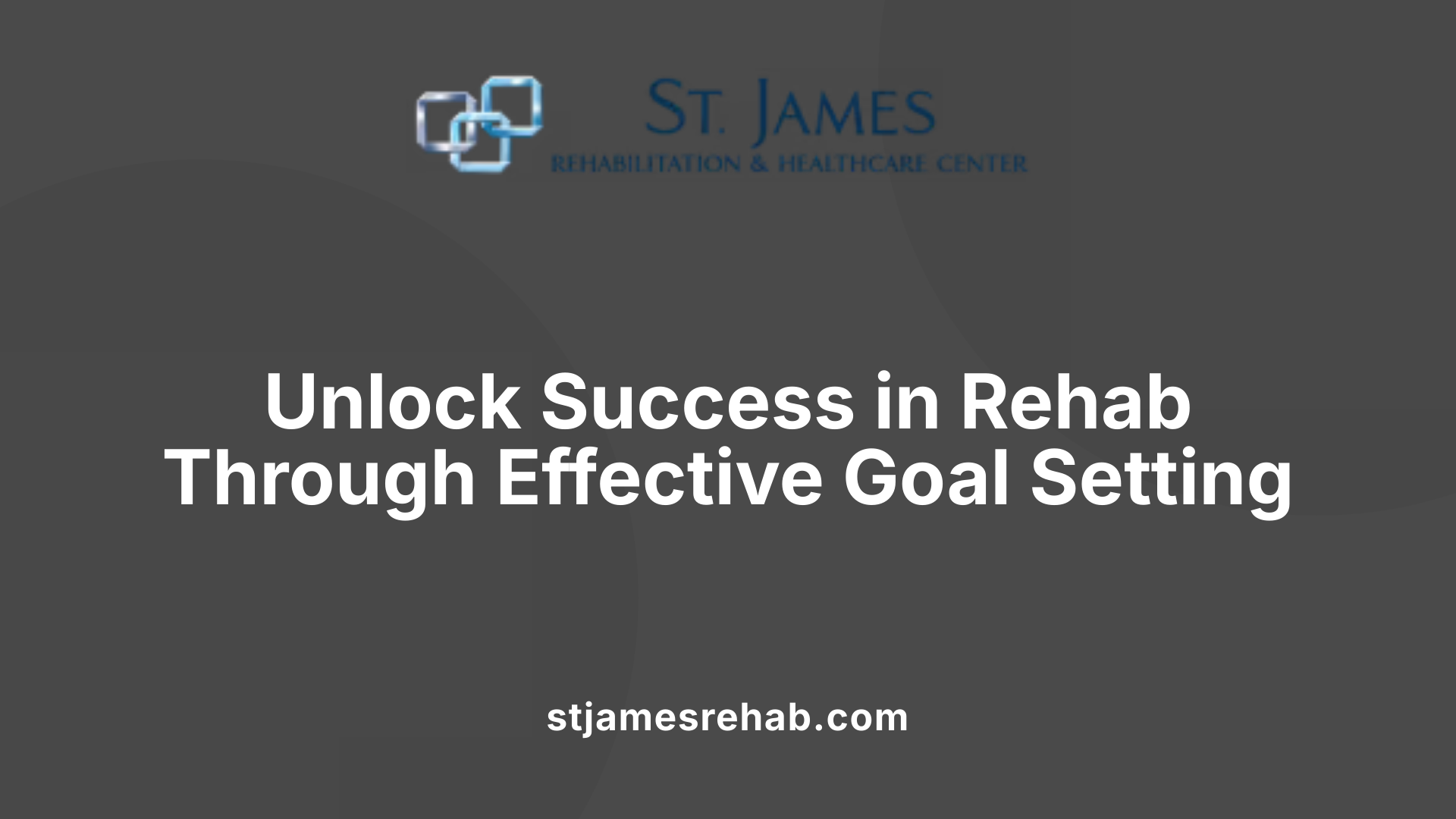
How does goal setting benefit recovery and rehabilitation success?
Goal setting plays a vital role in enhancing the effectiveness of recovery and rehabilitation efforts. It provides individuals with a clear roadmap, helping them understand what they need to accomplish and why it matters. Structured goals act as motivational anchors that keep individuals engaged and committed to their progress.
Utilizing specific frameworks like SMART (Specific, Measurable, Achievable, Relevant, Time-bound) ensures that goals are well-defined and attainable. For example, a goal like "attend physical therapy twice a week for the next month" is clear and measurable, encouraging accountability.
Breaking long-term recovery into smaller, manageable milestones allows individuals to celebrate small wins, boosting their confidence and encouraging continued effort. This step-by-step approach makes the process seem less overwhelming and more achievable.
Beyond physical progress, goal setting also nurtures emotional resilience and self-reliance. Success in achieving goals fosters a sense of control over one's life, decreasing feelings of helplessness often associated with addiction or injury.
In addition, incorporating the GAS (Goals Attainment Scaling) framework assists in tailoring objectives to match personal needs and circumstances. It emphasizes gradual improvement and personal growth, which are crucial in long-term recovery.
Support systems, such as therapists, peer groups, and family members, are integral in sustaining motivation and providing encouragement. Flexibility in adjusting goals allows individuals to adapt to unforeseen challenges without losing momentum.
Overall, structured goal setting creates a supportive environment that encourages behavioral change, enhances resilience, and promotes sustainable recovery. It empowers individuals to take active roles in their healing journeys, leading to better health outcomes and an increased quality of life.
Principles and Strategies of Effective Goal Setting
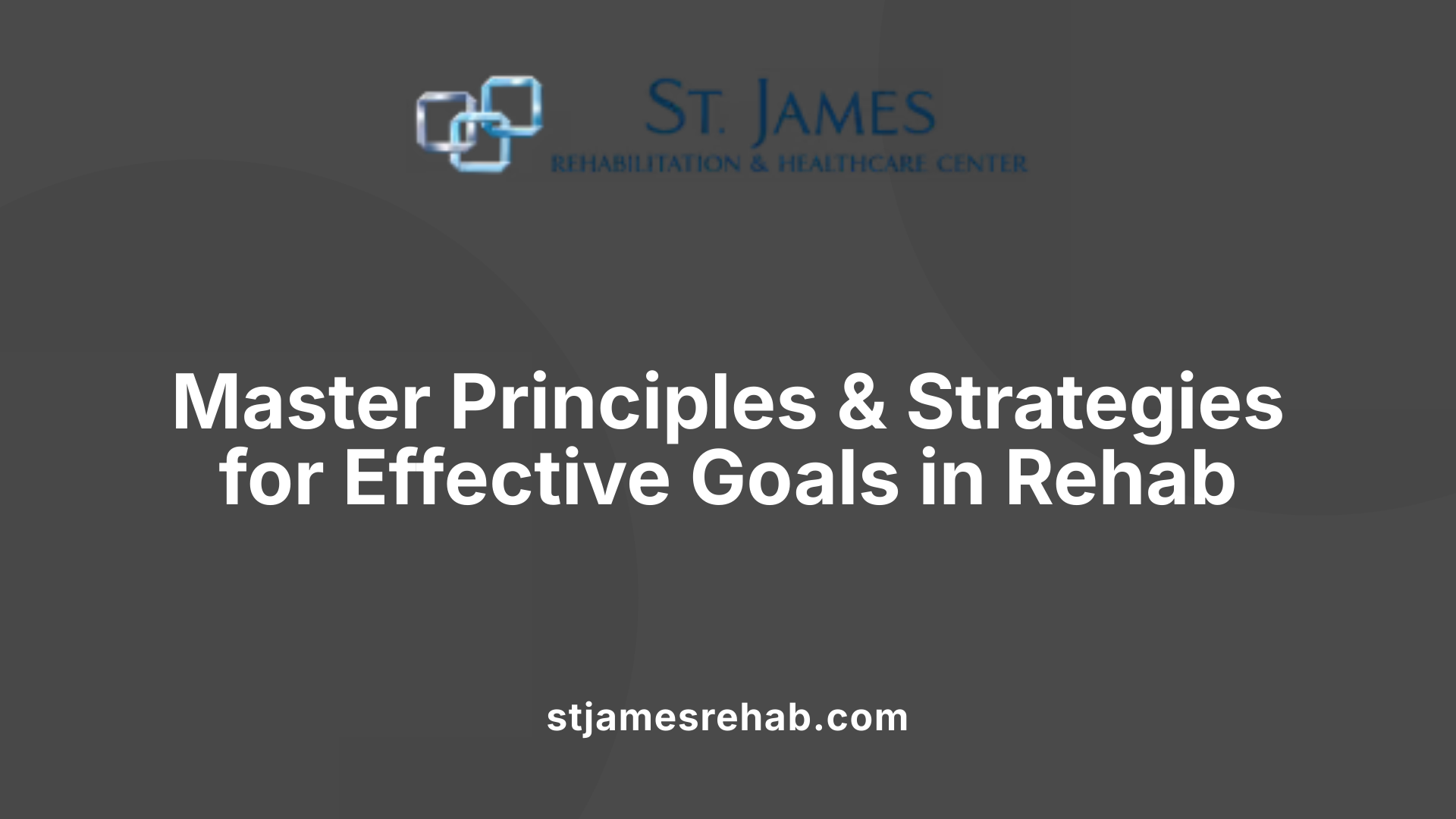
What principles and methods are used to set effective goals in rehabilitation?
Effective goal setting in rehabilitation revolves around creating clear, personalized, and meaningful objectives that foster motivation and progress. Two widely adopted frameworks include SMART (Specific, Measurable, Achievable, Relevant, Time-bound) and GAS (Goals, Actions, Support). These tools help structure goals that are realistic and aligned with individual needs.
The SMART framework ensures goals are well-defined and attainable within a specific timeframe. For example, a patient might aim to walk 100 meters unaided within four weeks, providing clarity and a measurable target.
GAS complements this by focusing on setting goals that consider the client’s broader aspirations, actions needed, and support systems. It supports adjusting goals based on ongoing progress and circumstances.
Beyond these structured methods, individual values and cultural contexts play a crucial role. Goals are aligned with clients’ core beliefs, cultural backgrounds, and personal motivations, encouraging deeper engagement.
This balance between substantive and instrumental rationalities helps clients find genuine relevance in their goals, making them more likely to commit and sustain effort.
How does collaborative exploration of clients’ inner experiences enhance goal setting?
A cornerstone of effective intervention is collaborating with clients to explore their inner experiences — such as physical sensations, emotions, thoughts, and spiritual beliefs.
This process deepens awareness, allowing clients to articulate what truly matters to them. For example, a client might discover that emotional connection with family is a key motivator for ongoing rehab efforts.
Therapists facilitate this exploration through respectful dialogue and reflection, helping clients clarify their inner worlds, which in turn informs goal formulation.
This approach ensures goals are aligned with personal values, increasing intrinsic motivation and the likelihood of success.
Mindfulness and goal-free living practices can also be integrated to help clients stay present and open to discovering insights during this process.
How can obstacles in goal setting be overcome?
Challenges such as difficulty in identifying appropriate goals, resistance to change, or fear of failure are common.
To overcome these, practitioners guide clients through inner exploration exercises that address underlying fears or ambivalence. Reframing goals to focus on achievable steps reduces resistance.
Clarifying and normalizing setbacks encourages resilience. Using tools like the BETAS System — which connects clients more deeply with their goals — can foster ongoing engagement and personal growth.
Integrating mindfulness and acceptance strategies, inspired by Eastern practices, supports present-moment awareness and reduces the urge to rush or avoid difficult feelings.
Balancing Western structured techniques with holistic, mindful approaches creates a supportive environment for overcoming obstacles.
Practitioners play a vital role as guides and facilitators, helping clients navigate the emotional landscape of goal setting and embracing their journey.
Overall, establishing effective, meaningful goals involves a blend of structured frameworks, personalized exploration, cultural sensitivity, and compassionate support, all aimed at fostering sustainable motivation and recovery.
Personalized and Collaborative Approaches to Goal Setting
Why is personalized and collaborative goal setting important in rehabilitation?
In rehabilitation, setting goals that are tailored to each individual’s unique needs, values, and life circumstances significantly enhances the effectiveness of the process. When goals reflect a person's core beliefs, goals, and attitudes—often referred to as their 'global meaning'—clients feel a stronger sense of purpose and motivation. Exploring these fundamental aspects helps healthcare providers establish meaningful overall goals that resonate deeply with clients.
This process involves engaging clients in discussions about their personal aspirations, daily routines, and what truly matters to them. Such exploration fosters a sense of connection to the rehabilitation journey, making goals more relevant and motivating. For example, aligning goals with a person’s desire to regain independence or improve relationships can propel them forward.
Moreover, collaborative goal setting involves shared decision-making between clients and clinicians. When individuals actively participate in defining their goals, they experience greater autonomy and confidence. This partnership supports commitment to the rehabilitation plan, as clients are more likely to pursue objectives they helped create.
Healthcare professionals also benefit from this approach. Incorporating comprehensive assessments—such as the International Classification of Functioning, Disability and Health (ICF)—ensures that goals cover physical, mental, and social domains. These frameworks provide a structured way to evaluate individual needs thoroughly, enabling more accurate and effective goal formulation.
Incorporating client participation and comprehensive assessments leads to better adherence to therapy, as goals feel more personalized and attainable. Clients are more inclined to stay engaged and motivated when they see their goals as reflections of their personal identity and values.
Ultimately, personalized and collaborative goal setting not only improves motivation and satisfaction but also fosters better health outcomes and sustained behavior change. It transforms rehabilitation from a generic procedure into a meaningful process aligned with what truly matters to the individual.
| Aspect | Importance | Details |
|---|---|---|
| Tailoring goals | Boosts engagement | Goals reflect individual values, needs, and life context |
| Shared decision-making | Enhances adherence | Clients actively participate, increasing commitment |
| Use of assessments | Guides effective planning | Tools like the ICF help define comprehensive, relevant goals |
| Motivation & adherence | Improves outcomes | Participant involvement sustains effort and focus |
This approach underscores the importance of respecting individual differences and fostering collaboration to optimize rehabilitation success.
Impact of Goal Setting on Treatment Strategies and Recovery Trajectories
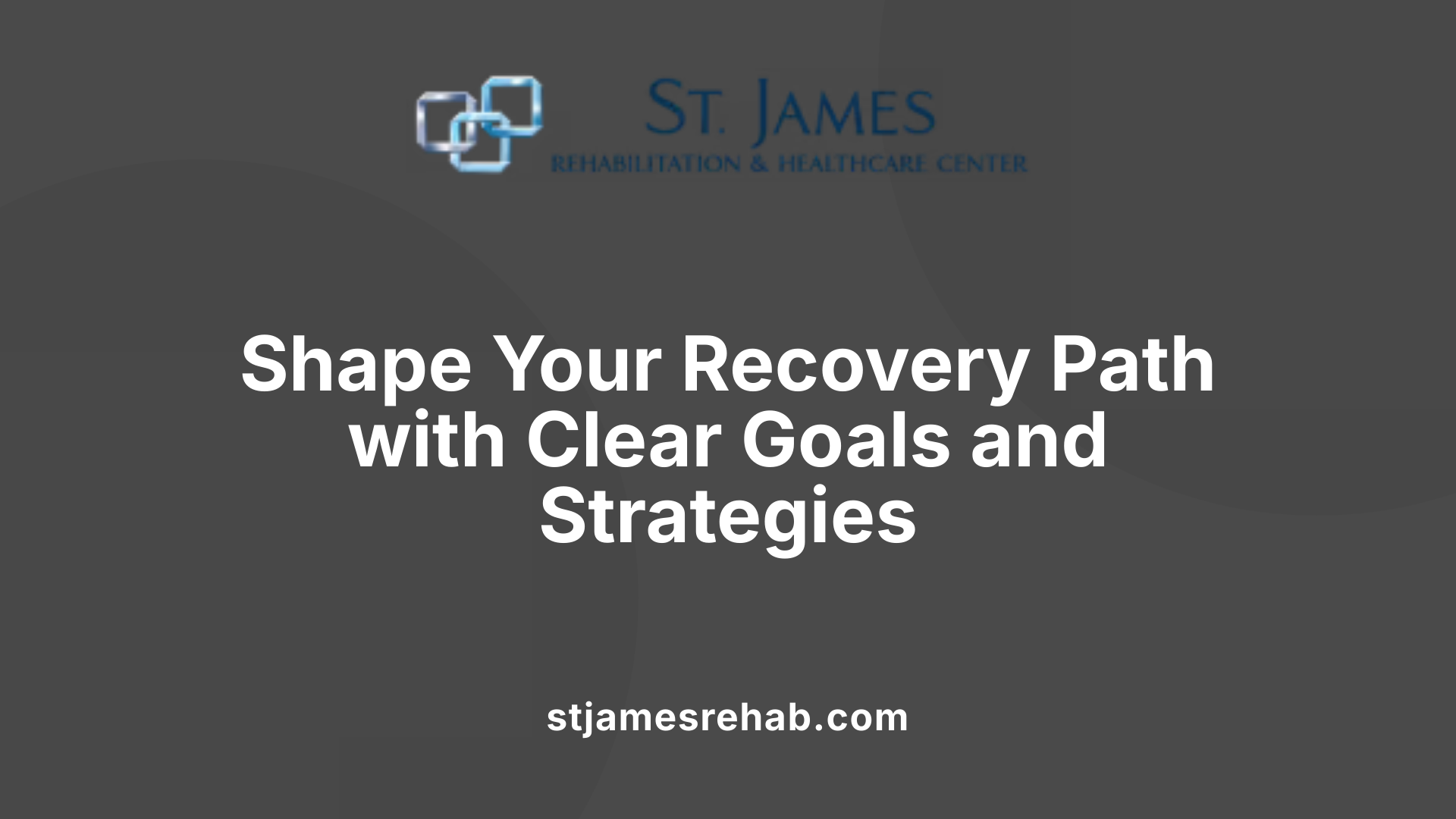
How does goal setting influence treatment strategies and recovery trajectories?
Goal setting plays a vital role in shaping effective treatment plans and guiding recovery progress. When personalized goals are aligned with an individual’s core beliefs and values, they serve as powerful motivators that inspire commitment and active engagement in the rehabilitation process.
One approach to fostering meaningful goal alignment is through exploring a client’s 'global meaning'—their fundamental beliefs, attitudes, and life aspirations—before establishing specific rehabilitation targets. This process helps clients and clinicians understand what truly matters to the person, ensuring that goals are relevant and motivating.
Structured goal frameworks like SMART (Specific, Measurable, Achievable, Relevant, Time-bound) and GAS (Goal Attainment Scaling) are instrumental in this context. These frameworks break down long-term ambitions into manageable steps, making the recovery process less overwhelming and more systematic.
For example, in addiction recovery, setting clear, measurable milestones such as maintaining sobriety for a specific period or improving communication skills encourages steady progress. Similarly, in physical rehabilitation, well-structured goals—like increasing mobility or building strength—are crucial for tracking effectiveness and adjusting strategies.
Regular reassessment and flexibility are also essential. Recovery is a dynamic journey; as individuals progress or encounter challenges, their goals should evolve accordingly. Frequent reviews, involving support networks and healthcare professionals, ensure that goals remain relevant and achievable, fostering resilience.
Moreover, involving support networks like family and peer groups in goal planning enhances accountability and emotional support. It also helps in adjusting goals to accommodate changing circumstances.
Overall, goal setting influences treatment strategies by creating a clear roadmap that boosts confidence, enhances motivation, and fosters a sense of control. This personalized, adaptable approach ultimately leads to better recovery outcomes and sustainable behavioral change.
| Aspect | Focus | Benefits |
|---|---|---|
| Personalization | Align goals with core beliefs and values | Increases engagement and motivation |
| Frameworks | Use SMART, GAS | Clarifies steps and tracks progress |
| Flexibility | Regular review and adjustment | Maintains relevance and resilience |
| Support Integration | Family, peers, professionals | Enhances accountability and emotional support |
| Overall Impact | Shaping treatment and recovery | Promotes confidence, motivation, and long-term success |
This comprehensive approach underscores the importance of structured, personalized, and adaptable goal setting in optimizing treatment strategies and strengthening recovery journeys.
Implementing and Overcoming Challenges in Goal Setting
How can active patient engagement enhance the goal-setting process?
Engaging patients actively in their rehabilitation journey is vital for effective goal setting. When patients participate in defining their goals, they are more likely to feel ownership and commitment. Approaches such as shared decision-making, where clinicians collaborate with patients to identify meaningful and realistic objectives, foster a sense of autonomy and relevance.
Building goals that resonate with a patient's personal interests and daily life increases motivation and adherence. For example, setting goals related to returning to hobbies or social activities can be more motivating than abstract clinical targets.
Involving family members and support networks can also reinforce commitment and provide additional encouragement. When patients see their goals as personally relevant and aligned with their values and aspirations, they are more likely to stay engaged, which contributes to better recovery outcomes.
How does the use of motivational interviewing and goal tools facilitate progress?
Motivational interviewing (MI) is a patient-centered counseling technique that helps resolve ambivalence, strengthen motivation, and promote behavioral change. Its application in goal setting involves exploring patients' motivations, values, and barriers, leading to more personalized and attainable goals.
Tools such as SMART (Specific, Measurable, Achievable, Relevant, Time-bound) frameworks help structure goals clearly. Incorporating digital health apps, wearable devices, and visual goal-tracking tools allows patients to easily monitor their progress, receive feedback, and stay motivated.
These strategies create a supportive environment where patients feel heard and empowered, increasing their confidence and commitment to rehabilitation.
Why is regular review and adjustment of goals necessary?
Recovery is a dynamic process, and patients’ needs, abilities, and circumstances can change over time. Regularly reviewing goals ensures they remain relevant and achievable. It allows clinicians and patients to celebrate milestones, recalibrate objectives, and address emerging challenges.
Adjustments might involve making goals more challenging to promote growth or more attainable when facing setbacks. For example, if a patient struggles with certain physical tasks, modifying the goal to smaller steps can maintain motivation.
Ongoing feedback and flexible goal management help sustain engagement, prevent frustration, and foster a sense of progress. This continuous process supports resilience and encourages patients to stay committed to their recovery plans.
How can barriers and resistance be effectively overcome?
Overcoming resistance involves understanding individual challenges and addressing them proactively. Common barriers include fear of failure, lack of motivation, limited understanding, or external obstacles like limited support.
Strategies include employing motivational interviewing to explore ambivalence and enhance internal motivation. Providing education about the benefits of goal achievement and involving patients in the planning process increases buy-in.
Creating an environment that emphasizes collaboration and respect helps reduce perceived confrontations or power struggles. Additionally, breaking down goals into smaller, manageable steps makes progress feel attainable, reducing anxiety.
Continual encouragement, positive reinforcement, and adaptable approaches are crucial. When setbacks occur, viewing them as learning opportunities rather than failures maintains motivation. Tailoring interventions to meet each patient's unique context fosters resilience and supports sustained engagement.
How is goal setting integrated into team-based rehabilitation practices?
Embedding goal-setting within the broader rehabilitation team enhances coherence and efficiency. Interdisciplinary collaboration ensures that all professionals—clinicians, therapists, physicians—are aligned in the objectives and strategies.
Structured team meetings to discuss progress, challenges, and adjustments promote consistency. Utilizing shared documentation tools and digital platforms facilitates communication and tracking.
Involving patients in team discussions about their goals encourages transparency and ensures that each team member understands the patient's priorities and motivations.
This collaborative approach not only improves the implementation of personalized goals but also fosters a person-centered environment that respects individual needs, ultimately leading to improved engagement and recovery success.
Concluding Insights on the Power of Goals in Holistic Recovery
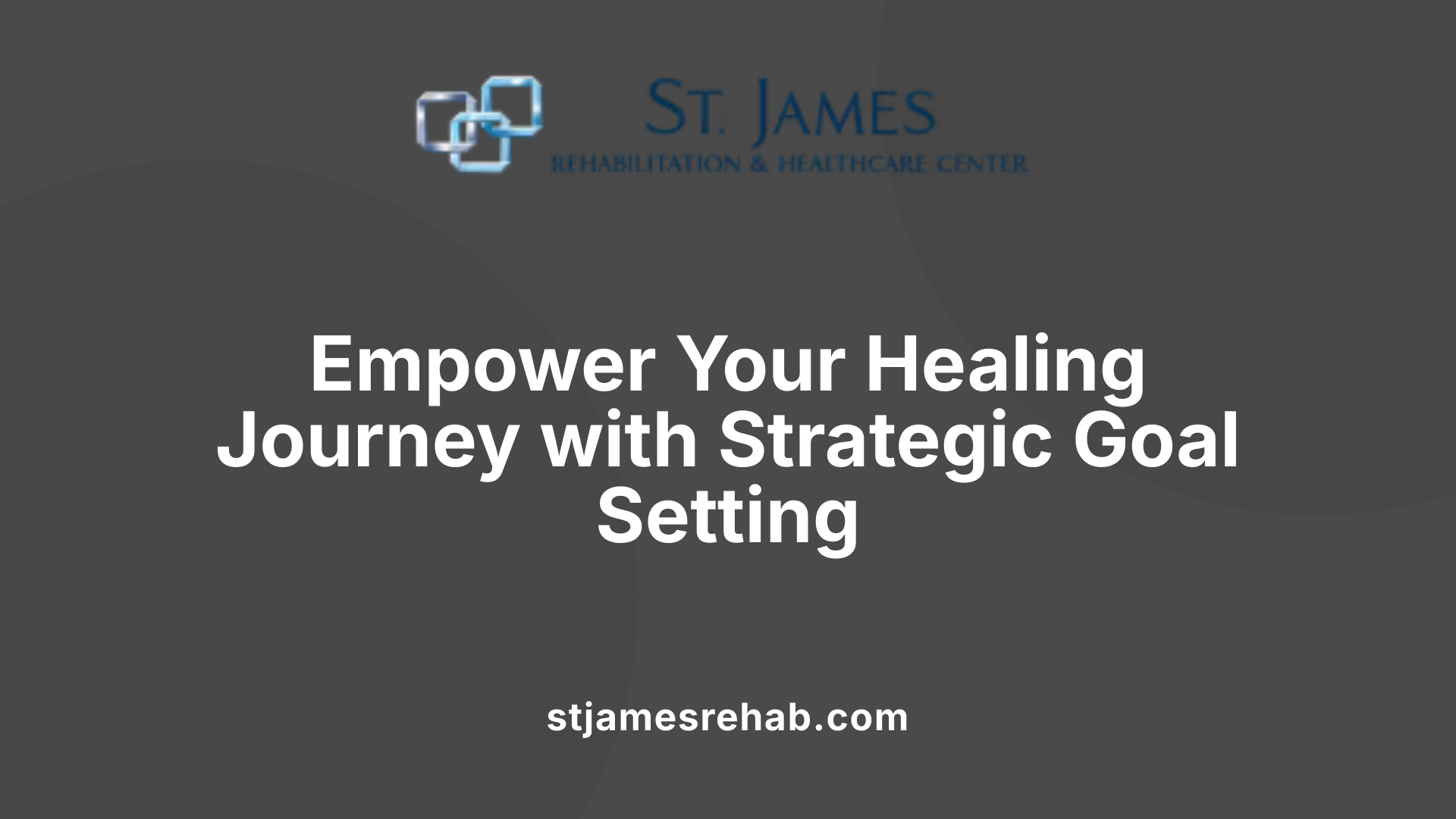
What is the importance of goal setting in a holistic rehabilitation plan?
Setting goals is a fundamental part of a successful holistic recovery process. It acts as a guiding framework, providing individuals with clear direction and purpose. By establishing specific objectives, clients can focus their efforts on meaningful activities that align with their personal values and life aspirations.
Goals help to motivate individuals by giving them attainable milestones to reach. This sense of progress reinforces commitment and encourages sustained effort, especially important in long-term recovery journeys such as addiction rehabilitation or physical therapy.
In addition, goal setting fosters behavior change. When clients understand what they want to achieve—like maintaining sobriety, improving physical health, or rebuilding relationships—they are more likely to adopt the behaviors necessary to reach those goals. Clinicians often utilize structured frameworks like SMART (Specific, Measurable, Achievable, Relevant, Time-bound) to craft realistic and personalized goals, making the recovery process manageable.
Furthermore, establishing shared objectives enhances communication and teamwork among healthcare providers, clients, families, and support networks. When everyone works toward aligned goals, it promotes coherence within the treatment team and increases the likelihood of positive outcomes.
The process of goal setting also contributes to improving mental well-being. Achieving small, measurable goals builds confidence and creates a sense of mastery. This, in turn, can alleviate feelings of helplessness or frustration often encountered during recovery.
Regular review and adjustment of goals allow for flexibility, ensuring that efforts remain relevant as circumstances evolve. Celebrating milestones—no matter how small—serves to motivate individuals further and provides tangible evidence of progress.
In summary, goal setting in a holistic health context is vital for fostering motivation, encouraging behavior change, aligning treatment efforts, boosting self-esteem, and ultimately supporting sustained recovery. It transforms abstract aspirations into concrete actions, empowering individuals to take control of their healing journey.
| Aspect of Goal Setting | Description | Impact on Recovery |
|---|---|---|
| Motivation | Provides reasons to stay committed | Increases engagement and perseverance |
| Behavior Change | Guides actions aligned with personal values | Facilitates healthier habits |
| Team Coherence | Aligns efforts across multiple stakeholders | Ensures consistent and supportive care |
| Confidence Building | Achieves milestones and receives feedback | Boosts self-efficacy |
| Flexibility | Allows goal adjustments as needed | Maintains relevance and motivation |
| Progress Monitoring | Tracks improvements over time | Identifies challenges early |
Understanding how goal setting integrates into a holistic recovery underscores its importance. Whether it’s rebuilding physical health, emotional stability, or social relationships, structured goals serve as the compass guiding individuals through their unique paths to healing.
Empowering Recovery Through Purposeful Goals
Incorporating structured, personalized, and holistic goal-setting strategies into rehabilitation creates a compelling framework that guides individuals through their recovery journey. When goals are aligned with personal values, culturally sensitive, and collaboratively developed, they foster motivation, resilience, and meaningful progress. Future advancements in goal-setting tools and approaches promise to enhance this process further, supporting more effective, patient-centered rehabilitation outcomes. Ultimately, the success of a holistic plan depends on ongoing reflection, flexibility, and the deep connection between goals and the individual's intrinsic motivations, paving the way for genuine transformation and long-term wellbeing.
References
- Setting meaningful goals in rehabilitation: A qualitative study on the ...
- Setting Rehabilitation Goals: What to Expect in Your Journey
- The Role of Goal Setting in Addiction Recovery
- The importance of goal-setting in rehabilitation
- Exploring goal planning in mental health service delivery
- How to Set Effective Goals for Your Recovery
- Setting Goals: What to Know Before You Begin Intensive Physical ...
- Why Recovery Goals are Important
- How Do Residential Rehab Programs Approach Goal Setting?
- How to Set Realistic Addiction Recovery Goals for the New Year






